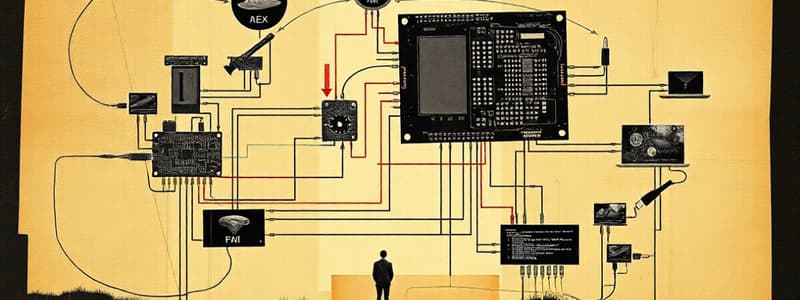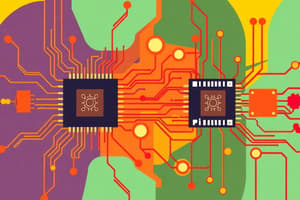Podcast
Questions and Answers
What is the goal of synchronization and replication in IoT and embedded systems?
What is the goal of synchronization and replication in IoT and embedded systems?
Understanding how synchronization and replication are applied in IoT and embedded systems.
What is distributed synchronization in IoT?
What is distributed synchronization in IoT?
It ensures that devices and sensors communicate and operate in a coordinated manner.
Which of the following is an example of synchronization in IoT?
Which of the following is an example of synchronization in IoT?
- A non-connected security camera
- A standalone temperature sensor
- A digital clock
- A smart irrigation system using soil moisture sensors (correct)
What protocols do IoT devices often rely on for time synchronization?
What protocols do IoT devices often rely on for time synchronization?
What is the importance of coordination in IoT systems?
What is the importance of coordination in IoT systems?
Which consensus protocol is commonly used in IoT to ensure agreement among devices?
Which consensus protocol is commonly used in IoT to ensure agreement among devices?
What is deadlock in the context of distributed IoT systems?
What is deadlock in the context of distributed IoT systems?
What could be a consequence of deadlock in a smart city traffic control system?
What could be a consequence of deadlock in a smart city traffic control system?
Name one algorithm that can help detect or prevent deadlock in distributed IoT systems.
Name one algorithm that can help detect or prevent deadlock in distributed IoT systems.
What is the goal of synchronization and replication in IoT and embedded systems?
What is the goal of synchronization and replication in IoT and embedded systems?
Embedded systems are at the core of IoT devices, often operating in a distributed environment such as ______.
Embedded systems are at the core of IoT devices, often operating in a distributed environment such as ______.
Synchronization in IoT is unnecessary for a seamless user experience.
Synchronization in IoT is unnecessary for a seamless user experience.
Why is distributed synchronization important in IoT?
Why is distributed synchronization important in IoT?
Provide an example of distributed synchronization in IoT.
Provide an example of distributed synchronization in IoT.
What are time synchronization protocols often used in IoT?
What are time synchronization protocols often used in IoT?
What is the definition of coordination in IoT systems?
What is the definition of coordination in IoT systems?
Request an example of coordination in embedded systems.
Request an example of coordination in embedded systems.
What protocols do IoT devices use to achieve consensus?
What protocols do IoT devices use to achieve consensus?
Deadlock in IoT occurs when devices are waiting on each other causing the system to continue functioning.
Deadlock in IoT occurs when devices are waiting on each other causing the system to continue functioning.
Provide an example of deadlock in an IoT environment.
Provide an example of deadlock in an IoT environment.
What are some algorithms used for deadlock detection and prevention in distributed IoT systems?
What are some algorithms used for deadlock detection and prevention in distributed IoT systems?
Flashcards are hidden until you start studying
Study Notes
Introduction
- Focus on synchronization and replication within IoT and embedded systems composed of interconnected devices.
- Embedded systems play a crucial role in IoT, operating in distributed environments like smart homes and autonomous vehicles.
- Synchronization enables harmonious operation and consistent communication among devices.
- Replication ensures reliability and fault tolerance, essential for real-time applications where failures are unacceptable.
Overview of Distributed Synchronization
- Distributed synchronization coordinates the communication and operation of devices and sensors in IoT.
- Devices often act autonomously, necessitating coordination for effective functioning (e.g., smart homes where lights and thermostats must work together).
- Lack of synchronization can result in inconsistent data and unpredictable system behavior.
Distributed Synchronization Examples
- Smart irrigation systems utilize synchronized moisture sensors to accurately determine when to water plants.
- Embedded systems in smart cars require synchronized sensors (LiDAR, cameras, GPS) to provide coherent environmental data, crucial for safety.
Time Synchronization Protocols
- IoT devices frequently use protocols like Network Time Protocol (NTP) to synchronize clocks for accurate event timing.
- Resource coordination prevents simultaneous access to shared resources using techniques like mutexes and semaphores.
Coordination and Agreement
- Coordination ensures consensus among distributed IoT devices, essential for decision-making and system updates.
- Active in dynamic environments, coordination maintains system functionality despite device failures or connectivity issues.
Coordination and Agreement Examples
- In smart grids, smart meters must agree on electricity usage data to ensure accurate reporting to central systems.
- In industrial IoT settings, machines coordinate to adjust production parameters in response to a malfunctioning machine.
Consensus Algorithms
- Protocols like Paxos and Raft are employed by IoT devices to reach agreement amidst potential node failures.
- Leader election algorithms (e.g., Bully Algorithm) designate a new leader when nodes fail, coordinating network activities.
Distributed Deadlock
- Deadlock arises when devices in an IoT system wait on each other, causing operational freezes—a significant risk in real-time systems.
- Prevention of deadlock is vital in distributed systems, such as smart traffic lights, to avoid interruptions.
Distributed Deadlock Examples
- Traffic control systems in smart cities can experience deadlock if intersections wait for each other to release traffic lanes.
- Fleet of autonomous delivery drones can face deadlock if two drones wait for each other to vacate airspace, resulting in delivery delays.
Deadlock Detection and Prevention
- Algorithms like Wait-Die or Wound-Wait can detect or alleviate deadlock in distributed IoT systems through resource allocation management.
- Deadlock recovery may involve rolling back one device to restore system functionality.
Introduction
- Understanding synchronization and replication is crucial in IoT and embedded systems with interconnected, real-time communication.
- Embedded systems form the backbone of IoT devices, commonly functioning in environments like smart homes and autonomous vehicles.
- Synchronization ensures devices operate harmoniously, while replication provides reliability and fault tolerance essential for real-time operations.
Overview of Distributed Synchronization
- Distributed synchronization enables coordinated communication between IoT devices and sensors.
- It is vital for autonomous devices to work together, particularly in smart homes where multiple systems, such as lights and security, must synchronize for an optimal user experience.
- Inconsistent synchronization may result in data discrepancies or unpredictable behaviors.
Examples of Distributed Synchronization
- Smart irrigation systems utilize soil moisture sensors to coordinate watering actions based on simultaneous moisture level reports.
- In smart cars, synchronization of embedded sensors like LiDAR, cameras, and GPS ensures accurate environmental data, crucial for safety in decision-making processes.
Time Synchronization Protocols
- IoT devices employ protocols such as Network Time Protocol (NTP) to maintain precise event timing through synchronized clocks.
- Resource coordination techniques, including mutexes and semaphores, prevent simultaneous access to shared resources, maintaining data consistency.
Coordination and Agreement
- Consensus among distributed IoT devices is critical for shared decisions, especially in security and system updates.
- IoT operates in unpredictable environments where device failures and connectivity loss can happen; effective coordination maintains system functionality.
Examples of Coordination and Agreement
- In smart grids, smart meters must reconcile electricity usage data; anomalies trigger consensus processes among all meters to uphold data accuracy.
- In industrial IoT, factory machines coordinate production parameters, adjusting real-time operations in response to malfunctions to prevent disruptions.
Consensus Algorithms
- Protocols like Paxos and Raft facilitate agreement among IoT devices even during node failures.
- Leader election algorithms such as the Bully Algorithm appoint a new leader to manage and coordinate device activities after node failures.
Distributed Deadlock
- Deadlock is a condition where devices are stuck waiting on each other, potentially crippling systems in real-time settings like smart cities or autonomous vehicles.
- In distributed IoT, interactions between devices necessitate deadlock prevention strategies to ensure uninterrupted system function.
Examples of Distributed Deadlock
- In smart cities, traffic control systems at intersections may face deadlock if two traffic systems wait on each other's control release, causing jams.
- A fleet of delivery drones could encounter delays if they wait for each other to vacate shared airspace.
Deadlock Detection and Prevention
- Algorithms like Wait-Die or Wound-Wait are designed to detect or prevent deadlocks in distributed IoT systems, managing resource allocation and process priorities effectively.
- Deadlock recovery strategies in IoT may involve rolling back one device’s state to resolve the deadlock condition.
Studying That Suits You
Use AI to generate personalized quizzes and flashcards to suit your learning preferences.




